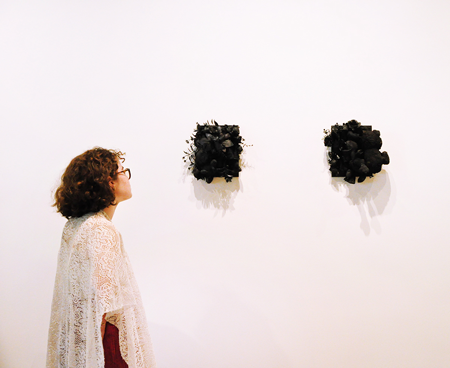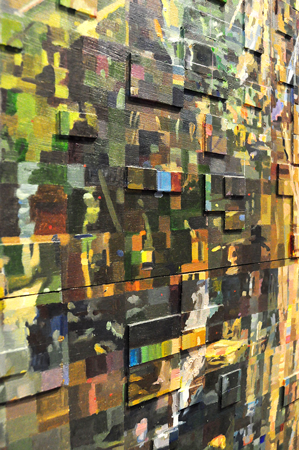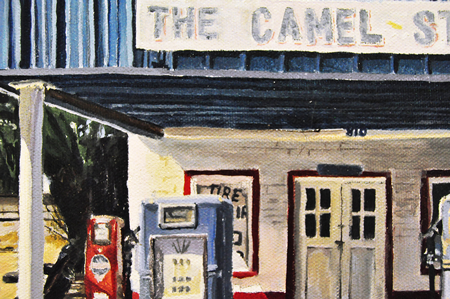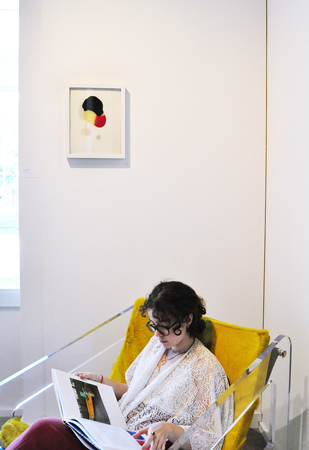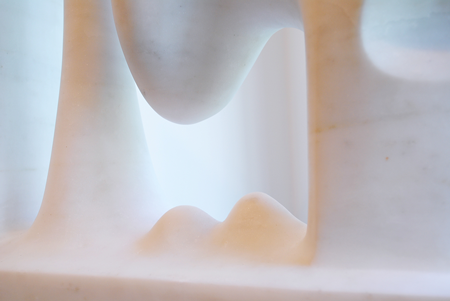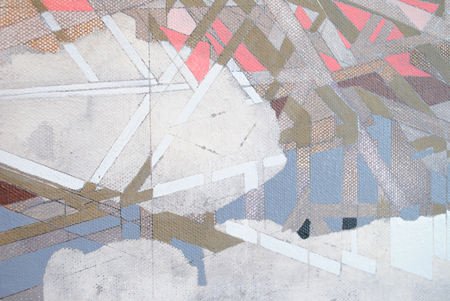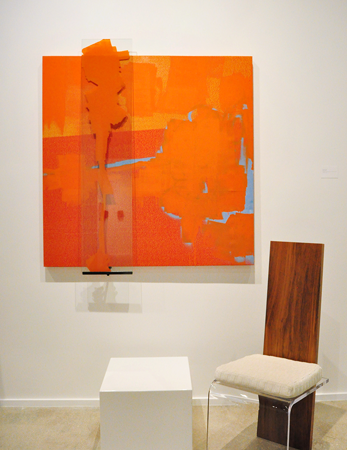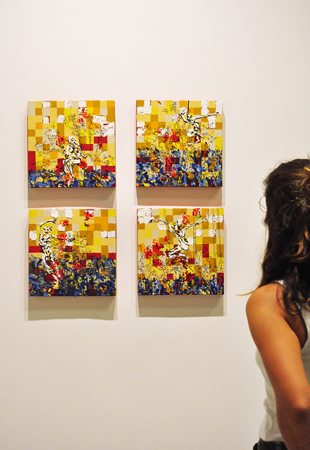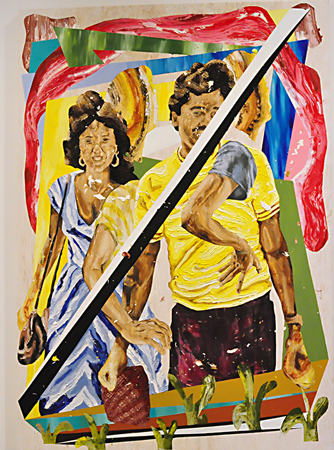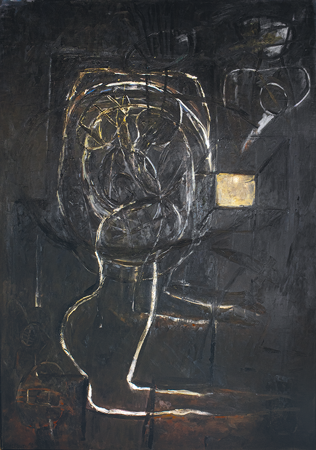The Summer Collective:
A Group Exhibition of 20+ Artists
Miami, Florida
July 14, 2020 – September 5, 2020
The Summer Collective:
A Group Exhibition of 20+ Artists
Dubbed the ‘Magic City,’ Miami is known as an international, tropical metropolis that connects the United States with Latin America and beyond. It holds a spirit evocative of possibility and mystery; a kaleidoscopic amalgamation of colors, tastes, histories, and memories. The Summer Collective: A Group Exhibition of 20+ Artists aims to represent the unique flavor of contemporary art that came to mature concurrently with the city’s development.
As Miami grew simultaneously with the arts that would come to represent it, the visual and lived cultures intertwined their roots, and wove the aesthetic representative of its population. The Summer Collective showcases artists emblematic to the art historical and daily happenings of Miami across the 20th and 21st centuries. From weighted emotions wrought by epidemic experiences, such as exile and AIDS, alienation and displacement, to the undeniable beauty of the Miamian landscape, both biotic and built, The Summer Collective: A Group Exhibition of 20+ Artists aims to contribute to the celebrated repertoire of the arts, here in Miami, Florida.
SELECTED WORKS
Jennifer Basile offers an escape to a mangrove oasis in Oleta III. Throughout her life, Basile has turned to nature for its vast healing aspect, through sublime beauty and escapism. Her practice of grand-scale prints creates an environment with which her audience receives the hypnotic effects of an untainted Floridian landscape. Oleta III is a window into our native state, a rendering of a scene experienced by Basile on a visit to Oleta State Park. Her medium allows her to emphasize the jeweled effect created by the mangrove leaves reflected in woven crystal waterways. The formal process with which Basile creates these renderings is emblematic of her meditative and labor-intensive medium. As an artist, Basile truly immerses herself in her work, as she scouts the locations that she later reproduces in her work by hiking, camping, and road-tripping through the raw, mystical world that exists in the backyard of our fast-paced society. Her hand-pulled, one-of-a-kind reduction prints expose each movement with which Basile recreates the scene for viewers, using a bold and undoubtedly endemic palette in the process.
Jennifer Basile (*1973 Manhasset, NY) lives and works in Miami, Florida. She received her BFA in Painting and Printmaking from the University of Miami in 1996 and her MFA from Southern Illinois University Edwardsville in 1999. Her most recent solo exhibition, The Power of Print: Iconic Images of the American Landscape by Jennifer Basile, at LnS Gallery, Miami, FL (2019) and Impressions of the American Landscape with Diversity Richmond at Iridian Gallery, Richmond, VA (2018), sets the pace for Basile’s body of work. Selected group exhibitions include, Bear/Bear with Us, Bernice Steinbaum Gallery, Miami, FL (2019), Oolite at LnS Gallery, Miami, FL (2017), Women’s Show, Palm Beach College, Palm Beach, FL (2017), Art New York, Bernice Steinbaum Gallery, New York, NY (2016), Work/Work, curated by Katherine Pill at MOAD Freedom Tower, Miami, FL (2016), Torrid Flora curated by Ananda de Mello, Pinecrest Gardens, Miami, FL (2015), Art in the Natural World and Cultured Settings, and Art Wynwood, Miami, FL (2015), She participated in Out of Eden and ArtSoBay at Deering Estate, Miami, FL (2010) following the completion of a residency program on the Estate. Basile’s work resides in the permanent collections of the Museum of Art & Design (Miami Dade College, Miami, FL), the Tucson Museum of Art (Tucson, AZ), and the Bernice Steinbaum Collection (Miami, FL).
In Hombre y Arroyo, Tomás Sánchez provides a mystical landscape composed of the grandeur, solitude, and healing powers which nature provides. Mixing a genus of trees on the bank of a secluded river, he uses calculated applications of acrylic on canvas to dwarf the singular figure he placed within the scene. The tropical vivacity of Mother Nature, along with the decision by Sánchez to tuck his human subject deep in this serene biome create a sense of voyeurism by the viewer, as if one is witnessing a moment of personal introspection taking place. These factors, along with the decision of scale invite the viewer to peer into a spiritual realm, following each brushstroke laid by Sánchez as a facet of a naturalistic mosaic, made as a tool of self-realization. Throughout his life, Sánchez has seen the range of atrocity reaped upon humanity in his native country of Cuba. While much of his work juxtaposes the sublime found within the natural world with the treatment of humans upon it, this particular scene acts as an amulet of healing. As a work of art created in the later stages of his career, Hombre y Arroyo infuses the artist’s personal life; his lived experiences, with the spiritual journey and the tools he has used to overcome them.
Tomás Sánchez (*1948 Cienfuegos, Cuba) studied at the San Alejandro National School of Fine Arts, and later graduated from the National Art School in Havana, Cuba in 1971. That same year he exhibited in the Young Arts National Exhibition, in the National Museum of Fine Art, Havana, Cuba. Exceptional solo exhibitions include Tomás Sánchez. Landscapes, at Galiano y Concordia Gallery, Havana, Cuba (1979), Tomás Sánchez. Drawings, from the Joan Miró Foundation, Barcelona, Spain (1981), Tomás Sánchez: Works on Paper, Marlborough Gallery, New York, NY (1988), Tomás Sánchez: Painting, Arvil Gallery, Mexico City, Mexico (1994), Tomás Sánchez: Recent Work, Marlborough Gallery, Madrid, Spain & Tomás Sánchez: Recent Work, at FIAC, Paris, France (both 1999), and Tomás Sánchez: Solo Presentation with Marlborough Gallery at TEFAF New York, Armory Building, New York, NY (2017). Notable group exhibitions include global shows, such as Intergrafik 73, Berlin, Germany (1973), V Graphic Art International Biennial, Krakow, Poland (1974), India Triennial, New Delhi, India (1975). Other selected group exhibitions include Cuban Painting and Graphic Art Outlook in Santa Clara, Cuba (1975), Cuban Art at Latin Gallery, Stockholm, Sweden (1981), XVI Painting International Festival at Cagnes-sur-Mer, France (1984), Art Miami 96 at International Art Exhibition, Miami Beach, FL (1996), and Witness Conscience in the X Havana Biennial, Havana, Cuba (2009).
As a three-dimensional artist, T. Eliott Mansa has a lengthy practice of using found materials to build the body of his wall-mounted sculptures. Mansa draws inspiration from the intrinsic apotropaic quality of objects – an idea emphasized in the West African practices of nkisi nkondi and bocio figurines– combined with the visual inspiration of roadside memorials and household shrines. Locally and across the United States, roadside shrines are created frequently to honor victims of senseless violence. While his practice takes stage in the contemporary art scene of Miami, Mansa injects ritual tied to Caribbean and African roots that both inform and inspire his work to ensure that each move made in the process of creation has purpose. In this coupled composition featured from a larger series, For Those Gathered in the Wind (XV & VI), Mansa calls to the visual memory of the viewer by using items of sentiment, inextricably activating an emotional response. The color palette choices chosen selected by Mansa further evokes the purpose with which these works of assemblage are made to possess. Offerings are presented to the shrines and accomplished here by Mansa’s monochromatic palette, leaving them bathed in color. While the wall-mounted presentation of these assemblages harkens back to the conventional history of painting, Mansa has provided provides viewers with his culmination of an amuletic work of art.
T. Eliott Mansa (*1977 Miami, FL) studied at Yale School of Art and later earned his MFA from CUNY Hunter College, New York, in 2018. The following year he was awarded the Creator Award from Oolite Arts and the Miami Foundation. Solo exhibitions include WOTY 1.2, New Work by T .Eliott Mansa, at Hunter East Harlem Gallery, East Harlem, NY (2017), BFI Presents T. Eliott Mansa, at Bas Fisher Invitational, Miami, FL (2013) and Mary Don’t You Weep/Martha Don’t You Moan, at the African American Museum of the Arts, Deland, FL (2009) where his work resides as part of their permanent collection. Notable group exhibitions include Notices of a Mutable Terrain, Piero Atchugarry Gallery, Miami, FL, Radio Silence, with FATVillage (Project Space), Ft. Lauderdale, FL, Reconstructing Identity at Historic Ward Rooming House, Miami, FL, Ever Upward, Collar Works, Troy, NY (all 2019), Alumni Series: Painting, New World Gallery, Miami, FL (2016), My Big Black America, Rush Arts Gallery, Brooklyn, NY (2015), Water Rites, Audrey Love Gallery at Bakehouse, Miami, FL (2013), and Art and Real Life: The Last Works of Master Artist Purvis Young, at the Purvis Young Art Museum, Miami, FL (2012).
Jake Fernández forges his style through piecing together experiences of submerging oneself in nature’s serenity. By breaking down the foundation of his materials, he creates a composite of a memory through reminiscence. In Untitled, Fernández follows his practice of layering individually painted fractals of wood with high impressionism. Through his unique formal process, he creates a space where the paint, along with the varying texture of these wooden surfaces, further complement the image laid upon them. Classically trained in landscape painting, Fernández uses his understanding of the timeless genre in order to portray nature’s ever-changing process. While his artistic interests began at a young age, a sense of impermanence became imbued upon Fernández through frequent relocation: from Havana to Gainesville, and later to New York. This inspired Fernández’s work, as he began to explore the ways with which he could capture the experience of nature without replicating it directly, encompassing the sensations, not solely the image. By approaching both his medium and subject with curiosity, Fernández is boundless in his artistic attempts to bring his vision to fruition by manifesting the fleeting experience of nature to an audience. Untitled follows this path, as he has reproduces a shady refuge built from tones of rich green and pale yellow, complete with shifts in shadow and movement between palm fronds.
Jake Fernández (*1951 Havana, Cuba) received his BFA from the University of Florida in 1976 and his MFA from the University of South Florida in 1979, with a consistency in practice shown by a lengthy exhibition history. Solo exhibitions showcasing Fernández’s work include, Jake Fernández: Black and White, TECO Public Gallery, Tampa, FL (2018), Jake Fernández: Second Nature, Benedictine University, Chicago, IL (2017), Jake Fernández: Constructed Landscapes, Art and History Museum, Maitland, FL (2014), and Jake Fernández: Sites and Composites, Frances Wolfson Art Gallery, Miami, FL (1998). Notable group exhibitions include, Visions and Imagination: Cuban American and Argentinian Art, Binghamton University, New York (2019), Fountain of Youth, Thomas Center Gallery, Gainesville, FL (2013), Florida Landscapes, Mrs. Lawton Chiles Collection, Anna Maria Island, FL (2010), The Interpretive Landscape, Present Global Art Gallery, West Palm Beach, FL (2008), Made in Florida: The Contemporary Landscape, The Von Leibig Art Center, Naples, FL (2004), Environments, Westwood Gallery, New York, NY (2000), and Latin American Spectrum, Elite Galleries, Coral Gables, FL (1991). His work resides in the permanent collections of the Contemporary Art Museum ( USF, Tampa, FL), Snite Museum (University of Notre Dame, Notre Dame, IN), Institute for Research in Art, University of South Florida Museum (Tampa, FL) and multiple State of Florida buildings in Jacksonville, FL.
Master of modernism, Emilio Sanchez, frequently elevated the simple structures and shapes present in passing life through his artwork. Forging a style inspired by the ocular archive of his colorful life and surroundings would become the legacy of Sanchez throughout his vast body of work. Untitled (Barbados Barrack) displays this thematic inspiration through and through, staying consistent with his vibrant architectural studies which took over the later part of his career. In Untitled (Barbados Barrack), hard diagonals and sweeping shadows show the skill with which Sanchez transforms recognizable spaces into abstract landscapes. Minty greens and sky blues paired with a range of tonal grays further drive the optical juxtaposition. By using a reductionist process, Sanchez elevates his subject matter by emphasizing the formal components that summate them. From the hues of the Caribbean, reflective of his youth between Camagüey and Miami, to the bold atmosphere he encountered when attending the Art Students League of New York, Sanchez, in order to document and interpret the world he lives in, created a language all his own.
Emilio Sanchez (*1921, Camagüey, Cuba *1999, Warwick, NY) attended the Art Students League from 1944 to 1948, and spent the majority of his mature life in New York. By the 1950s, Sanchez was exhibiting worldwide, he had participated in both group and solo shows such as those held in Lyceum Gallery (Cuba), and others in Chile, Puerto Rico, Spain, London, and Paris. His work stood in the Inter-American Graphics Biennale, Santiago, Chile (1968), Art Fair, Basel, Switzerland (1973 & 1978), Latin American Prints from the Museum of Modern Art, New York (1974), Lejos de Cuba, Aix-en-Provence, France, Our Americas: The Latino Presence in American Art, Smithsonian American Art Museum, Washington, DC (2013), and Inside/Out at the Pérez Art Museum, Miami, FL (2017-2018). His work permanently resides in the collections of the Art Museum of the Americas (Washington, DC), The Bronx Museum of the Arts (Bronx, NY), The Patricia and Phillip Frost Art Museum (Miami, FL), Lowe Art Museum (MIami, FL) the Metropolitan Museum of Art (New York, NY), Museum of Modern Art (New York, NY), Museo Nacional de Bellas Artes (Havana, Cuba), and the National Portrait Gallery (Washtingon, DC).
As a Miami-based artist, Tim Buwalda encounters the relationship between an urban city, and the resilience of the land it is often laid upon. Here, in Viewshed I, Buwalda explores a separation from his iconic automotive subjects while keeping consistency in theme. By elevating a vacant gas station through strong formalism, Buwalda separates his style from photorealistic reproductions and places his practice in the realm of naturalism via the malleability of his subjects. Rather than treating the gas station as what one conventionally interprets as a gas station, his choice of title, Viewshed I, lets viewers into the conscious decisions he made when framing his subject to illuminate the forms created by the architecture and shadows that compose the scene laid out before him. He juxtaposes objects with the space they occupy, masterfully done in this intimate canvas. Buwalda elevates the abandoned Camel Stop emblematic of the American Southwest through his handling of light and color. Reminiscent of works by artists like Richard Estes and Edward Hopper, Buwalda calls to both of these figures who spent their artistic career immortalizing an era of Americana through both painting and photography. The sense of serenity that permeates through Viewshed I transforms a commonplace road trip scene into an opportunity for contemplation, challenging the viewer to expand their senses in order to appreciate the aesthetics of place.
Tim Buwalda (*1975, West Palm Beach, FL) earned his BFA at New World School of the Arts in Miami, FL. Solo exhibitions by Buwalda include, Neighborhood Projects, LnS Gallery, Miami, FL (2019), Buwalda’s Body Shop, North Miami Avenue, Miami, FL (2014), and The Modern Prometheus, Fredric Snitzer Gallery, Miami, FL (2014). He has participated in group exhibitions including, Oolite, and The Collective Debut, LnS Gallery, Miami, FL (2017), Alternative Contemporaneity: TAZ, Museum of Contemporary Art, Miami, FL (2015), Vanishing Points, Bass Museum of Art, Miami, FL (2011), Drive, David Klein Gallery, Detroit, MI (2010), Florida Contemporary, Naples Museum of Art, Naples, FL, and, Boy, oh Boy!, Fredric Snitzer Gallery, Miami, FL (both 2010). The work of Buwalda resides in the permanent collections of the Pérez Art Museum Miami (Miami, FL) and Institute of Contemporary Art of Miami (Miami, FL).
Cuban born, Miami-based artist, Gustavo Acosta, focuses his creative energy into producing a body of work that uncovers the destructive forces built within our societal narratives. Through his visual investigation of the footprint impressed upon a continuous narrative of humanity via infrastructure, Acosta aims to create an archive in which the ubiquitous nature of the human experience is undeniable. La Casa de Juan presents viewers with a failed nuclear plant, pixelated through a varying schematic of purple tones. The geometric nature of his subject parallels the stylistic method with which he chooses to approach it; a tactic which allows him to adopt a recognizable urban landscape into his referential system of images, effectively illuminating viewers to the illusory nature of what are generally conceived to be distinct spaces. Acosta displays fine handling of his medium, meticulously rendering each facet within his transformed landscapes and challenging viewers to distinguish a rendition from reality. Through the amalgamation of these formal decisions, Acosta shifts his brick and mortar sources of inspiration to straddle a fine line between reality and falsity, one drawn towards a path of ambiguity.
Gustavo Acosta (*1958 Havana, Cuba) works out of the city he calls home, Miami, FL. He received his BFA from the School of Visual Arts San Alejandro (Havana, Cuba) and later attended the Superior Institute of Art (ISA) (Havana, Cuba). Selected solo exhibitions include Structural Narratives, Pan American Art Projects, Miami, FL (2018), Inventory of Omissions, 532 Thomas Jaeckel Gallery, New York, NY (2017), Space of Silence, Caixa Cultural, Sao Paulo, Brazil (2014), A Journal of References, Frederic Boloix Fine Art, Ketchum, ID & DUDA, Raymaluz Art Gallery, Madrid, Spain (both 2012), Transit Zones, Latin American Masters, Los Angeles, CA (2008), Hallucinations, Elite Fine Arts, Miami, FL (2000). Group exhibitions include Castles in the Sky: Fantasy Architecture in Contemporary Art, Lehman College Art Gallery, New York, NY (2019), Cuban Contemporary Art, Collective I, Raw Pace, Vero Beach, FL (2017), Cuban Art, The 80’s Generation, Museo Linares, Nuevo Leon, Mexico (2015), and De Ida y Vuelta, The Spanish Cultural Center, Miami, FL (2004). His work resides in the public collections of the National Museum of Fine Arts (Havana, Cuba), Museum of Contemporary Art, MOCA (Miami, FL), Lowe Art Museum (Miami, FL), Museo del Barrio (New York, NY), and the Wifredo Lam Center (Havana, Cuba).
Multifaceted Cuban artist and activist, Dolores “Loló” Soldevilla, spent her life pursuing her passions. Falling in line with much of Soldevilla’s contemporaneous works, Untitled reflects the rhythmic multimedia compositions she produced during the 1950s. Individually cut and colored spheres mirror an arch of vertical rectangles, with each geometric group coming to a crescendo in a palette reminiscent of the era. Through a rather involved political career, Soldevilla gained the opportunity to travel to Paris in order to promote the Cuban Avant-Garde in the continuously sought-after Parisian art scene. However, she ultimately became hypnotized by the range of styles displayed within the internationally acclaimed Salons, pushing her to pursue her own artistic journey. As Loló was entering her forties, she began channeling her energy further into her artistic pursuits, and after visiting US museums in Chicago and New York, she moved to Paris permanently in 1949, with her first solo exhibition debuting a year later. Her style is built on a concentration of contrast through her use of shape, hard lines, and a polarized palette, deeply reminiscent of the kinetic sculptural aesthetic forged by Alexander Calder. Soldevilla frequently employs repetition as a necessary facet to the musicality of her work, regardless of medium. Soldevilla’s life as a politician informed her work as an artist, as she deeply believed her modernist, minimal style reflected the new social order that would land in Cuba post-World War II.
Loló Soldevilla (*1901 Pinar del Rio, Cuba *1971 Havana, Cuba) lived in Paris, France for a period when her passion for art developed, later bringing it back to her native Cuba. Solo shows include Lolo: Luz y Construccion, Regional Habana, Havana, Cuba (1964), Lolo Pinturas Recientes, Galeria de Arte Color Luz, Havana, Cuba (1959), Lolo: Oleos, Collages, relieves Luminosos 1953-56 at Instituto de Cultura, Palacio de Bellas Artes, Havana, Cuba (1957) and Lolo Collages, Galerie la Roue, Paris, France (1955). Notable group exhibitions during her life include, Salon 70, Museo Nacional de Bellas Artes, Havana, Cuba (1970), Pittura Cubana Oggi (Cuban Painting Today), Instituto Italo-Latinoamericano, Rome, Italy (1968), Op Art, Pop Art, la Luna y Yo, Galeria de la Habana, Havana, Cuba (1966), Expresionismo Abstracto 1963, Galeria Habana, Havana, Cuba (1963), Exposicion de Pintura Cubana, organized by Consejo Nacional de Cultura in (traveling exhibition: Budapest, Prague, Warsaw, Sofia, Bucharest, and Moscow, 1962), and 8 Pintores Cubanos Oleos, Gouache, Dibujos y Collages, Centro de Bellas Artes de Maracaibo (Maracaibo, Venezuela). Her work resides in the permanent collection of the Galeria de Arte Contemporaneo (Havana, Cuba).
Fernando García
Jazz Babies VIII, 1988
acrylic on canvas on wood
3 1/2 x 48 x 1 1/2 inches
8.89 x 121.92 x 3.81 cm.
Jazz Babies VII, 1988
acrylic on canvas on wood
3 1/2 x 48 x 1 1/2 inches
8.89 x 121.92 x 3.81 cm.
Jazz Babies III, 1988
acrylic on canvas on wood
3 1/2 x 72 x 1 1/2 inches
8.89 x 182.88 x 3.81 cm.
Artist Fernando García was a vanguard figure in the Miami Generation of the 1980s, creating work easily recognized by its geometric and vibrantly colored bodies. Garcia received a B.S. in Physics and Mathematics from the University of Georgia in Athens in 1968, later earning graduate credits in mathematics from Georgia State University, and utilized mathematical concepts throughout his short but fruitful career. García was conceptually bold, and used his artistic practice as a means to reflect the world around him while tangentially infusing his productions with celebrations, criticisms, and commentary to leave a lasting message; one that would be emblematic of a unique moment in Miami’s history. The influx of Cuban emigration and simultaneous growth of the city’s contemporary art scene created an environment in which the young artists of the Miami Generation came to reach maturity in a decade that would actively contribute to the historical art footprint left on the metropolitan city. Jazz Babies VIII, VII, III do justice to Garcia’s iconic aesthetic through these vibrantly constructed, wall-mounted sculptures. Within Jazz Babies, García displays his exploration of the quadro-count found within musical composition through a symphony of shapes in abstracted and irregular segments of four. In the true nature of the artist, García imbued his interests of count, geometry, and pattern found in both the natural and constructed world throughout his work, and through this interdisciplinary approach, allows the mind of the maker to come out through artistic legacy.
Fernando García (*1945, Havana, Cuba *1989, Miami, FL) earned a B.S. in Physics and Mathematics from the University of Georgia in Athens in 1968. Notable solo shows included On the Line: A Simultaneous Exhibition in Key West and Coral Gables. FL; Miami Magic, an installation at the Metro Dade Cultural Center, and Aries: Installation, at the Albany Museum of Art, GA. His work was included in the Miami Generation traveling exhibition. His work is in the permanent collections of the Miami-Dade Public Library, Miami Dade College, and the Museum of Art in Fort Lauderdale, among others.
In this early composition created after relocating to Miami, Venezuelan native Tony Vazquez-Figueroa explores the mark making that results from the spill technique that later became emblematic within his practice. Reminiscent of color field artists, Vazquez-Figueroa allows his medium to establish itself in its natural forms to solidify the beauty within organicism. Deeply inspired by the dripping quality of crude oil that has driven his homeland historically and resulting in deep socioeconomic effect, Color Spill III is a facet of Vazquez-Figueroa’s practice that employs these themes in a precursory manner. Using a simple color palette of pale yellow, crimson, and black, Color Spill III comes together through the layering and transparency of resin laid upon synthetic paper, playing on the formal qualities of painting. This elegant composition is part of a series where Vazquez-Figueroa plays out the ideas of materiality that he later manipulates in his iconic blackened sculptures and large-scale installations. Throughout his body of work, Vazquez-Figueroa aims to create a personal archive in order to translate the experience imbued upon him by his early life in Venezuela, through a constructivist process with control over the medium that veritably controlled the environment in which he was raised. Color Spill III and its accompaniments in the series provide a dignified method for him to show the genesis of these ideas.
Tony Vazquez-Figueroa (*1970 Caracas, Venezuela) resides and works in Miami, Florida. He received his BFA in Film from Emerson College (Boston, MA) in 1992 and continued his art studies at the San Alejandro Academy (Havana, Cuba) and then at the New York Studio School, where he earned a scholarship to study at the institution. He then finished his formal training in 2002 at the Slade School of Painting at the University College London, under the tutelage of Jenny Saville. Selected solo exhibitions include the focus exhibition Spectacular Modernity at Zona Maco, Mexico City, Mexico (2020), Drawing from the Underdeveloped/Line One, LnS Gallery, Miami, FL (2019), Black Surface: The Undoing Process, LnS Gallery, Miami, FL (2018), Crude Inventory, Galeria Rozas-Botran Zona 14, Guatemala (2017), Venezuela Turmoil at South Florida Art Center (Art Basel Week) Miami, FL (2004) and Retro/Perspective, Centro Cultural Capuy in Caracas, Venezuela (2003). Notable group exhibitions include, The Artful Book, LnS Gallery, Miami, FL, Referencias y dialogos, Beatriz Gil Galeria, Caracas, Venezuela (both 2019), Oolite, LnS Gallery, Routes of Influence, Pérez Art Museum Miami, (both Miami, FL 2019), Inventory Takes, The Clemente Soto Velez Cultural Center, New York, NY (2016), and Tridimensionnel, Galerie 208, Paris, France (2012). His work resides in the permanent collections of the Pérez Art Museum (Miami, FL), Museum of Latin American Art (Longbeach, CA), Klugler Kaplan Collection (Miami, FL) and the Villanueva Collection (Venezuela).
Agustín Cárdenas began his life in the city of Matanzas, Cuba, where he studied at the Academy of Fine Arts in San Alejandro. As a young adult, Cárdenas brought endemic influences to Paris where he aided in the cultivation of sculpture within the Surrealist movement. Just shy of thirty years old, he participated in a group exhibition, heeding the advice of André Breton, which not only solidified his position within the movement, but proved to be a moment that catalyzed his career. Ventana en el Jardin (Window in the Garden) is representative of works produced at the height of Cárdenas’s artistic development, utilizing a geometric yet fluid aesthetic woven from threads of Dogon totems and known masters within his practice, such as Constantin Brâncuși and Jean Arp. Through Ventana en el Jardin (Window in the Garden), Cárdenas created a portal using weighted, biomorphic figures imposed upon an otherwise cloudless view through his constructed window. For Cárdenas, his interest in sculpture was most likely rooted from his Congolese background. Dogon sculptures are deeply ritualistic, with everything from the materials used, to totemic icons, and methods of display each carrying their own spiritual weight. Cárdenas transferred this animistic quality through this work with Pentelic marble, hand carving the ancient material once used in the creation of Athenian sculptures to create his portal, a window to contemplate both the physical world and the metaphysical absolutes it disguises. It is important to note that a window can be used to look both inward and outward, playing to the persistent dualism that has accompanied Cárdenas throughout his life experiences, artistic journey, and cultural influences.
Agustín Cárdenas (*1927 Matanzas, Cuba *2001 Havana, Cuba), began his career in Cuba by studying under Juan José Sicre from 1943 to 1949 at the the Escuela Nacional de Bellas Artes San Alejandro (Havana, Cuba) but built his career and worked out of Paris for many years. Notable solo shows include Retrospectives in both Milan, Italy and Paris, France (1997), International Art Exhibition, Miami, FL (1991), Invitational One-man Show, Chicago, IL (1990), FIAC, Paris, France (1984), Museo de Bella Artes, Caracas, Venezuela (1981), Galerie du Dragon, Paris, France (1961), Galleria Schwarz, Milan, Italy & Richard Feigen Gallery, Chicago, IL (both 1962), and Galerie de la Cour d’Ingres (Presented by André Breton) Paris, France (1959). Group exhibitions include Cuba, siglo XX, Palma de Majorca, Barcelona, Spain, Surrealism and Love, Pavillon des Arts, Paris, France (both 1997), Thirty Latin American Sculptors, Cultural Center of Mexico, Paris, France (1992), International Exhibition of Contemporary Sculpture, Collioure, Catalonia, Spain (1986), Festival de Lyon, Lyon, France (1978), and Formas en el Espacio, Galeria Theo, Madrid, Spain (1976). The work of Cárdenas resides in the permanent collections of the Musée de la Sculpture en Plein Air (Paris, France), Hakone Open-Air Museum (Hakone, Japan), Museo de Bellas Artes (Caracas, Venezuela), and Museo Nacional de Bellas Artes de la Habana (Havana, Cuba).
CLOCKWISE
Natalia Garcia-Lee
Single Family Home #2, 2019
Single Family Home #3, 2019
Single Family Home #6, 2019
Single Family Home #5, 2019
Single Family Home #8, 2019
Single Family Home #1, 2019
Single Family Home #10, 2019
Single Family Home #7, 2019
Single Family Home #9, 2019
Single Family Home #4, 2019
oil on canvas
12 x 12 inches each
20.48 x 30.48 cm. each
Miami-based artist Natalia Garcia-Lee uses her practice to decode distinctive zones of human behavior. From collage to canvas, Garcia-Lee displays her fascination with the science behind our seemingly logical thoughts and the societies that manifest themselves through her personal artistic processing of each facet. The Single Family Home Series is a suite of paintings that aim to work through our species’ needs for shelter, aiming to answer the ‘why’ and ‘how’ of our built societies. Garcia-Lee’s series-based format is iconic of her practice, and allows her to reiterate and further question structures that not only house, but analogously control, our world. The Single Family Home Series shows her utilization of stencils, in distinctive reiterations of what is commonly recognized as a ‘home.’ Four walls and slatted roof tops lay within compositions that disguise such recognizable symbols, allowing for viewers to project their personal inferences on differing installments of the subject. While Garcia-Lee employs an optical icon reminiscent of the nuclear family, the subject at hand applies to a wider range of architectural metaphors that challenge viewers to question how built societies have essentially constructed their own containment.
Natalia Garcia-Lee (*1971 Madrid, Spain) works in Miami, FL and received her BFA in Sculpture from the Pratt Institute (Brooklyn, NY) in 1995. Her latest solo show was exhibited at Deering Estate (Miami, FL), as part of the Spring Contemporary Projects (2020). The body of work focused on her exploration of ‘Monkey Mind,’ the Buddhist concept of a reactive, versus a logical, functioning of the mind. She previously exhibited in Fall Highlights, LnS Gallery, Miami, FL (2019).
One of the most iconic figures of the 20th century, Roberto Matta has long been understood as a figurehead in the monumental movement that would radically affect the direction and progression of subsequent movements, well into the twentieth century. With an exploration of the human psyche during the chaotic historical era that ensued, Matta used his practice as a means to translate the unspoken nuances that bubbled to the surface with compositions reminiscent of hypnagogic landscapes. La Tierra (El Peru) se Disfruta is characteristic of later works created by Matta, and displays his maturity in style, combining biomorphic skeletal figures with ghostly masses in a boundless space and leading the viewer to create relationships that animate the scene. It is essential to note Matta’s architectural background, which may have led to his career-long tendency to create cinematic stills, as he plays with space, light, and the exchange between operational figures that interact with one another throughout these compositions. He is admirably noted for his created environments, and contemporaries, such as Marcel Duchamp, have considered him to be among the most profound painters of his time. Matta’s legacy endures, as his masterful works continuously reach the depths of his viewers with a brand of surrealism aimed to express facets of the vast and intangible mind.
Roberto Matta (*1911 Santiago, Chile *2002 Civitavecchia, Italy) graduated from Pontificia Universidad Catolica de Chile (1935) with a concentration on architecture, but later focused his creative energy towards his artwork. Solo shows include Don Qui. El Quijote de Matta shown at Museo de Bellas Artes de Bilbao (Bilbao, Spain) & Instituto Cervantes, Madrid, Spain (both 2011), Roberto Matta: Architect of Surrealism, Art Museum of the Americas, Washington, DC & Matta: Sin Titulo, Casa d’Arte Ulisse, Rome, Italy (both 2003), Matta, Museo Nacional Centro de Arte Reina Sofia, Madrid, Spain (1999), Matta, N’oef, Galleria Erha, Milan, Italy (1994) and Matta: El Verbo America, Palacio de Cristal (1983). Notable group exhibitions include Image and Abstraction, Pace Gallery, New York, NY, Matta: Roberto Sebastian Matta, Gordon Matta-Clark, Pablo Echaurren Matta, Fondazione Querini Stampalia, Venice, Italy (both 2013), Masterworks from Degas to Rosenquist, Acquavella Galleries, New York, NY (2012), Traces du Sacre, Centre Pompidou, Musee National d’Art Moderne, Paris, France (2008), Latin American and Carribean Art: MoMA at El Museo, El Museo del Barrio, New York, NY (2004), Onnasch: Aspects of Contemporary Art, Museu d’Art Contemporani de Barcelona, Barcelona, Spain (2001), Chile Vive: Muestra de Arte y Cultura, Circulo de Bellas Artes, Madrid, Spain (1987), and Acquisition Priorities. Aspects of Postwar Painting in Europe, The Solomon R. Guggenheim Museum, New York (1983), Art Figuratif Latino-Americain, Centre Culturel Aerospatiale, Toulouse, France (1983). Matta’s work resides in the permanent collections of the Musée d’Art Moderne de la Ville de Paris (Paris, France), Museo Thyssen-Bornemisza (Madrid, Spain), Museo Botero (Bogota, Colombia), Museum of Fine Arts (Boston, MA), Museum of Modern Art (New York, NY), Pérez Art Museum (Miami, FL), The Solomon R. Guggenheim Museum (New York, NY), and Tate Collections (London, England).
Rafael Soriano, a leading figure in the establishment of Latin American modernism, infused his work with explorations of spiritualism to uncover the depth that lies in the human experience. Through the later part of his career, Soriano shifted to become a true figurehead in decoding the role of the spirit through nuances of surrealism. In 1962, Soriano was exiled from Cuba and relocated to Miami, resulting in deep trauma and a radical shift in his artistic career. After a creative impasse that lasted years, Soriano delved back into his practice with a changed aesthetic. Soriano created a body of work that aims to capture the light within humankind, distilled, and wrapped in chiffon-like layers of color to allow the luminosity to show through the canvas. In El Ilusionista, Soriano presents a vaguely rendered subject, wielding a similarly constructed cloud above, both made to act as vehicles for the tropological message he aimed to convey. What he presents is not a true figurative representation, but raw emotion that must then be veiled and transformed to be received by a terrestrial audience. It is evident through Soriano’s layered use of color that he carefully swaddles critical points of connection, allowing a warm glow to reveal the cerebral relationship of the organic groups to one another. Calling to traditional portraiture of the Late Renaissance, the severe and total blackout of the background pushes his subjects forward, providing viewers a focused opportunity to explore the endless microcosm that lies within the work.
Rafael Soriano (*1920 Matanzas, Cuba *2015 Miami, FL) graduated from the Escuela Nacional de Bellas Artes San Alejandro as a Professor of Painting, Drawing and Sculpture in 1941. He lived and worked as an artist and educator in Matanzas, Cuba, until 1962 before relocating to Miami and continuing his preset paths as both a painter and professor. Most recent solo exhibitions include Cabezas (Heads), American Museum of the Cuban Diaspora, Miami, FL (2020) & Art Museum of the Americas (AMA) Washington, DC (2019), Rafael Soriano: The Artist as Mystic, The McMullen Museum, Boston College Boston, MA, Long Beach Museum of Art, Long Beach, CA, & The Patricia & Phillip Frost Art Museum (2017-18) and Other Worlds Within, The Lowe Art Museum, Miami, FL (2011). Notable group exhibitions include Between the Real and Imagined: Abstract Art from CINTAS Fellows, Coral Gables Art Museum, Coral Gables, FL (2017), Masters of Cuba, Gary Nader Gallery, New York, NY (2017), Concrete Cuba, David Zwirner Gallery, Chelsea, NY (2017), and London, England (2015), traveling exhibition Our America: The Latino Presence in American Art, spearheaded by Smithsonian American Art Museum, Washington, DC (2013-2016), Latin American Masters III, organized by Gary Nader Fine Arts in Coral Gables, FL (1996 International Tour: Galeria Tomas Andreu, Santiago, Chile. Museo Pedro de Osma, Lima Peru. Galeria Gary Nader, Santo Domingo Dominican Republic. Museo de las Americas, San Juan, Puerto Rico), Pintura Cubana, Galerica Internacional, Caracas Venezuela (1971). His work resides in the permanent collections of the Smithsonian American Art Museum (Washington, DC), Bacardi Imports (Miami, FL), Cuban Museum of Arts and Culture (Miami, FL), Lowe Art Museum at University of Miami (Miami, FL), Museo de Arte (Matanzas, Cuba), and Pérez Art Museum (Miami, FL).
Conceptual artist Florencio Gelabert is most recognized for the body of fictional ruins he has produced over the decades of his career. Having grown up playing games of war in his youth, he became familiar with ideas, both created and concrete, surrounding decimated urban landscapes. Following in the footsteps of his father, modernist sculptor José Florencio Gelabert Pérez, Florencio Gelabert Jr. forged a minimalist style that would stand out in his field of contemporary art through his utilization of a playful yet timeless message. Gelabert’s practice is steeped in a personal archaeology that he builds out through a method of deconstruction, using industrial materials in his ruinous imagery to evoke the past and present lives of objects while on a quest to understand the purpose of our built societies. Displacement XI was conceived as a facet within a larger body of work that operates as a playground of destruction reminiscent of his adolescent memories. In this wall-mounted sculpture, Displacement XI presents viewers with the subliminal beauty found within a shattered piece of ceramic, prodding a dark curiosity that exists within humans to look after natural disasters, accidents, or venues of war. By finding the beauty in destruction, Gelabert insets the poetic dualism of humanity through this simple yet powerful composition.
Florencio Gelabert (*1961 Havana, Cuba) obtained an MA from the Higher Institute of Art (Havana, Cuba) in 1989, and earned his MFA from the University of Miami in 1998. Solo exhibitions include DISPLACEMENT: Icebox, Miami, FL (2018-2019), Journeys: A Dialogue with Time, Museum of Art and Design (MOAD), Miami, FL (2015), and Personal Landscapes, Magnan Emrich Contemporary Art, New York, NY (2006). Notable group exhibitions include ZONA MACO Art Fair, Art Nexus Stand, Mexico City, Mexico (2020), UTOPIAS PARLELAS, Palau de la Virreina, Barcelona, Spain (2019), OFF/BY/FOR, American Museum of the Cuban Diaspora, Miami, FL (2017-2018), Destination: Latin America, Neuberger Museum of Art at Purchase College, New York, NY (2016), WILD NOISE: Bronx/Havana, The Bronx Museum of the Arts, Bronx, NY (2016), Behind the Wall Project: 12th Havana Biennial, Havana, Cuba (2015), CARIBBEAN: TOGETHER APART, Luciano Benetton Collection, Treviso, Italy (2014), IV Bienal Barro de America, Museo del Bellas Artes, Caracas, Venezuela (2002). Public commissions include The Paraiso Park at Gran Paraiso on the Bay (Miami, FL) and the Socrates Sculpture Park (New York, NY). Gelabert’s work resides in the permanent collections of the Pérez Art Museum (Miami, FL), Museum of Latin American Art (Long Beach, CA), New Mexico Museum of Art (Santa Fe, NM), Museo De Arte Contemporáneo (Panama City, Panama) and Cisneros Collection (Caracas, Venezuela).
Miami native and sculptor Michael Loveland uses his practice to reclaim the city he calls home. Using found objects, Loveland repurposes commonplace objects, sometimes seen as waste, to create dynamic, wall-mounted compositions. As someone who has seen the vast growth and drastic change of the metropolitan city, Loveland aims to immortalize facets of these communal experiences by transforming them within his arctic practice. In Close Up, a discarded billboard becomes his canvas, complete with mounted glass and a vibrant palette, inviting viewers to take a closer look and experience the range of textures and dimensions he has created. Transformation plays a large part in the effect of his work, for the inherent value of these objects is elevated by their place within these wall-mounted sculptures. Close Up is emblematic of Loveland’s larger message, exposing his desire to inform viewers of the vast lives, and afterlives held by objects as he composes them in this manner to derive new meaning. Influenced by twentieth century icon Robert Rauschenberg and philosophies birthed in postmodernism, Loveland breaks the contrived boundaries surrounding fine art. He exploits his reclaimed mediums and explores their optical value, thus proving the transcendental nature of manmade objects within our consumerist society.
Michael Loveland (*1973 Miami, FL) lives and works in his native city and graduated from the New World School of the Arts (Miami, FL) in 1991, later earning his BFA from the Maryland Institute College of Art (Baltimore, MD) in 1994. Throughout his career, he has accumulated an extensive exhibition list, with solo exhibitions including the Sculpture Installation & Park Design commissioned by the Pérez Art Museum, Miami, FL & Sight Specific Mural, 1010 Brickell Property, Miami, FL (both 2017), RIP CURRENT, Bas Fisher Invitational, Miami, FL (2015), North West Utopia, Wynwood Art Fair, Miami, FL (2011), and Recent Developments, Denise Bibro Fine Arts, New York, NY (2008). Notable group shows include MERE FACADE: Curated Group Exhibition of 20 Miami Based Artists, Spinello Projects, Miami, FL (2017), Trilateration, Diana Lowenstein Gallery, Miami, FL (2016), Pine Rock Land with artist Ralph Provisero, Miami, FL, Black and White curated by Katherine Mikesell, Miami, FL, & + One Exhibition at Deering Estate, Miami, FL (all 2015), Rock and Soft Place, CasaLin, Miami, FL (2010), and GEO-Graphic, Diana Lowenstein Gallery, Miami, FL (2009). His work resides in the permanent collections of the Pérez Art Museum (Miami, FL), Lowe Art Museum at University of Miami (Miami, FL), The Margulies Collection at the Warehouse (Miami, FL), and Brooklyn Museum of Art (Brooklyn, NY).
Cuban-American artist Mario Bencomo spent the majority of his life in a state of flux when it came to establishing a sense of place, one he eased through his artistic pursuits. At an impressionable age, Bencomo experienced a transatlantic journey that would uproot his life, and catalyze a skew of thematics within his body of work. Deeply inspired by lived experiences, the natural world, and the art of literature, Bencomo’s muses were endlessly abundant. While Bencomo has developed an iconic abstract expressionist style through collage, he emphasizes different facets of his medium miscellany when needed, as displayed here in A Poem by Severo Sarduy. In Bencomo’s ode to the daring author and friend, he composes Sarduy’s words within the red brick-like fragments that provide an intimate, yet bold space for Sarduy’s words to reside. Bencomo keeps true to his thematic relationships, allowing the fluid poetics that celebrate nature to juxtapose the textured geometric background he creates. A loving note, “a Mario Bencomo, de Servero Sarduy,” reveals the deeper levels of collage, as the viewer is let into the cherished exchange, timelessly captured on paper.
Mario Bencomo (*1953, Pinar del Rio, Cuba) lives and works in Miami, Florida. He holds an extensive exhibition history, with important solo exhibitions including Visual Poetry (Focus Installation), LnS Gallery, Miami, FL (2019), Drawn from Poetry, The Americas Collection, Coral Gables, FL (2006), If Quebec were in the Tropics, The Americas Collection, Coral Gables, FL (2005), and Noche Insular: Jardines Invisibles, shown at Galeria Art Consult, Panama City, Panama & Forma Gallery, Coral Gables, FL (both 1984). Notable group shows include Between the Real and the Imagined: Abstract Art from CINTAS Fellowship, Coral Gables Museum, Miami, FL (2017), Montreal-Vues de la Ville, Galerie Beaux-arts des Ameriques, Montreal Canada (2014), The Expressive Edge of Paper, Anita Shapolsky Gallery, New York, NY (2014), Almacenes Abiertos, National Museum of Fine Arts, Havana, Cuba & El Viento del Sur, Galerie Beaux-arts des Ameriques, Montreal Canada (both 2013), and the traveling exhibition CUBA/USA: The First Generation that showcased across Miami, FL, Tampa, FL, Washington, DC, Chicago, IL, and Philadelphia, PA (1991). His work resides in the permanent collections of El Museo del Barrio (New York, NY), National Museum of Fine Arts (Havana, Cuba), Art Museum of the Americas (Washington, DC), Pérez Art Museum (Miami, FL), Lowe Art Museum at University of Miami (Miami, FL) and The Metropolitan Museum of Art (New York, NY).
French-American painter and printmaker John William Bailly has spent his career aiming to expose consistencies within accepted written histories to understand the larger enigma that is humanity. He does so by layering mechanisms derived by distinctly different societies throughout these histories—separated by centuries, or existing across oceans—to distill a sense of truth. Deeply inspired by mythology, geography, and the diversity found within nature itself, Bailly employs these facets and pieces together a personal understanding of a universal experience. In this suite of paintings, Maria de Miami, Prometheus de Miami, Mary Magdalene de Miami, and Christ de Miami, Bailly places deities celebrated through both the religious and artistic histories of the West within the perennial mangrove marshes that were once occupied by native tribes of South Florida. He transpires the figures that populate Greco-Roman mythology, along with Biblical characters, in an act of both transcendence and displacement to provoke viewers to question their roots. By nature, Bailly is exceedingly academic in his artistic pursuits. From his technical approach to the historical references he injects within these vibrant compositions, he ensures that each stroke laid upon the canvas serves a purpose in his artistic pursuit to answer enduring anthropologic questions.
John William Bailly (*1968, London, England) received his BFA from Florida International University in 1990 and his MFA in painting and printmaking from Yale University in 1993. His most recent solo exhibition, The Roses of Fibonacci, was showcased at LnS Gallery in Miami, Florida, concurrently with Art Basel this past winter (2019). Additional solo shows include, 10,000 Years of Miami, displayed at Miami International Airport (2017) and Deering Estate (2016) Miami, FL, Cinquante Fifty, Clos des Arts, Brindas, France (2013) & The Patricia & Phillip Frost Art Museum, Miami, FL (2010), Place of Mind, exhibited at ClampArt, New York City, and University of Maine Museum of Art, Bangor, Maine (both 2013), Wonder World, The Art Gallery at Government Center, Miami, FL (2005) and Encyclopedia, Borders Art Gallery, Miami, FL (2002). In 2007, Bailly and former US inaugural poet Richard Blanco coordinated Place of Mind – A Collaborative Project with Richard Blanco, curated by Denise Delgado at the Miami-Dade Public Library Main Branch (Miami, FL). Notable group exhibitions include The Artful Book, LnS Gallery, Miami, FL (2019), Oolite, LnS Gallery, Miami, FL, MemoryLab 2017, HistoryMiami Museum, Miami, FL (both 2017) Sense of Place, Carol Jazzar Contemporary Art, Miami, FL (2010), Miami: Visions of Now, J. Johnson Gallery, Jacksonville, FL (2004), and Sarasota Biennial at the John and Mable Ringling Museum of Art, Sarasota, FL (2000).
World-renowned master painter Arturo Rodríguez infuses his experience of a migratory youth within his body of work through subject, artistic influences, and execution. As an impressionable teen, Rodríguez made the journey from Cuba across the Atlantic Ocean to Spain before settling in Miami: a metropolis built on sensory traces of the tropics through its mixed population and history. Rodríguez uses a universal experience of displacement as a focal point within his iconic series, Arcimboldo’s Ghosts. In this grand composition, Arcimboldo, Diane Arbus, Sharaku, Utamaro Ghost, the figure stands as a mosaicked portrait; displaying enlarged faces and graphic handling reminiscent of Edo-period printmakers and the estranged emotion captured in portraits by photographer Diane Arbus, translated through a striking palette of produce iconic of Italian mannerist Giuseppe Arcimboldo. The phantasmal figures Rodríguez constructs are an amalgamation of lonely icons, distinctive within the history of both fine art and photography, that function for Rodríguez as a wave of preternatural migrants that each encapsulate a sense of isolation and displacement.
Arturo Rodríguez (*1956 Ranchuelo, Cuba) lives and works in Miami, Florida. The two-time CINTAS Fellowship recipient holds an extensive exhibition history, with notable solo shows including, Arcimboldo’s Ghosts, LnS Gallery, Miami, FL (2018), Arturo Rodriguez: The School of Night, shown across New York, NY and Miami, FL (all 2014), Arturo Rodriguez: PASSENGERS, Waltman-Ortega Fine Art, Miami, FL (2012), and Exiles – Arturo Rodriguez, Durban Art Gallery, Madrid, Spain. Group shows include the traveling exhibition, Our America: The Latino Presence in American Art, spearheaded by the American Art Museum (Smithsonian), Washington, DC (2013-2014), Lists: To Dos, The Morgan Library & Museum, New York, NY (2011), Season’s Greetings from the Archives of American Art, Smithsonian’s Reynolds Center for American Art and Portraiture, Washington, DC (2010), Unbroken Ties: Dialogues in Cuban Art, Museum of Art, Fort Lauderdale (2008). His work resides in the permanent collection of the Lowe Art Museum at University of Miami (Miami, FL), American Art Museum: Smithsonian (Washington, DC), The Israel Museum (Jerusalem), Maria Zambrano Museum (Malaga, Spain), Norton Museum of Art (West Palm Beach, FL), Pérez Art Museum (Miami, FL), and the Metropolitan Museum of Art (New York, NY).
Through his practice, César Trasobares reflects a bicultural personal saga while honoring celebrated masters in the history of art. FOREVER OPEN follows this thematic thread, as he engages not only his own experiences, but actively challenges viewers by sourcing and mixing imagery from various traditions. An emblematic figure of The Miami Generation, Trasobares initially imbued his work with experiences of exile and transplantation. This unique aesthetic shared with some of his contemporaries bridged the boundaries of objective representation with psychological and political nuances posed by the syncretic aesthetic of that generation. In FOREVER OPEN, Trasobares utilizes a medical room divider as his canvas and composes a symphony of biomorphic, abstracted organisms, almost generated automatically, reminiscent of the phantasmagoric apparitions created by Hieronymus Bosch, the fantastic and fanciful creatures painted by Joan Miró and the abstractions of Roberto Matta. By using materials thought to be unconventional, Trasobares employs myriad formal approaches in his constructions as his worldview expanded beyond locality and the narrow expressions of displaced individuals. The physicality of this sculpture, including the fleeting shadows activated by changing light conditions, allow for interpretations beyond the standing syntax of language, the logic of science and the conventions of cultural realms. In this context, Trasobares brings us art that encourages the examination and questioning of the limits of actual time, the probing of microscopic life and the exploration of universal pictorial space.
César Trasobares (*1949 Holguín, Cuba) lives and works in Miami, Florida. He received his B.A. from Florida Atlantic University and pursued graduate studies in Art History at Florida State University. Notable exhibitions include solo shows, REDACTED, at LnS Gallery, Miami, FL (2018), TENDERHOUSE, de la Cruz Collection, Miami Design District, FL (2006), and SOCIAL FABRIC: Old Pillows and Recent Money at the Green Library Gallery, Florida International University, Miami, FL (2002). Group shows include The Artful Book, LnS Gallery, Miami, FL (2019), Oolite, LnS Gallery, Miami, FL (2017), PHILODENDRON: FROM PAN-LATIN EXOTIC TO AMERICAN MODERN, The Wolfsonian-FIU Museum, Miami Beach, FL (2015), The Miami Generation: Revisited, NSU Art Museum, Ft. Lauderdale, FL (2014), Human Rites, The Bass Museum of Art, Miami Beach, FL (2010), KILLING TIME, Exit Art, New York, NY (2007), Pulp Fashion, Gallery at Dieu Donne Papermill, New York, NY (1996), CUBA SIGLO XX: Modernidad y Sincretismo, a traveling exhibition curated by Maria Lluïsa Borràs, Centro Atlántico de Arte Moderno, Las Palmas de Gran Canaria, Spain, Fundació “La Caixa,” Palma de Mallorca, Spain, Centre d’Art Santa Mònica, Barcelona, Spain (all 1995), CUBA USA: The First Generation: Exhibition Tour, 1991-1992, Fondo del Sol Visual Arts Center, Washington, DC (1991), Outside Cuba / Fuera de Cuba, Zimmerli Art Museum, Rutgers University, Brunswick, NY (1987), and The Miami Generation: Nine Cuban-American Artists, Cuban Museum of Arts and Culture, Miami, FL (1983).
Cuban born, Miami-based artist William Osorio uses conventional methods in his approach to painting, yet the theoretical message that shines through his striking compositions is birthed from a place of deconstruction. Throughout his practice, expressionist interpretations of people and their experiences have become emblematic of his work, yet the subjects he aims to convey are not the limbs or faces of the figures, but the transformative events that are stirring within them. His latest rendering, Eve II (Vispera), presents viewers with a jubilant, young couple after a long-awaited reunion, framed by bold bands of color. Osorio places subsidiary limbs within the portrait to evoke a level of movement, reminiscent of the Cubist desire to show more than one moment and more than one dimension. The fixation on exposing ‘more’ to the viewer launches Eve II (Vispera) for Osorio, allowing him to employ the canvas as a tool to discuss the concept of time on the human experience. Osorio thinks of us as a species conditioned by this construct of “living in a perpetual eve of events.” In this scene of conciliation, two fragmented figures occupy the canvas, yet the true subject of Osorio’s work is the essence of time and its accompanying collateral effects.
William Osorio (*1989 Holguin, Cuba) initiated his studies at the School of Fine Arts in his city of Holguin and later lived and worked in Boston, MA after migrating to the United States. He now works in Miami, Florida, the city he calls home. Inside Out, Osorio’s solo show, was displayed at LnS Gallery, Miami, FL in 2018. Notable group exhibitions include Oolite, LnS Gallery, Miami, FL (2017), The Collective Debut, LnS Gallery, Miami, FL (2017), Spectrum Art Fair, Miami Art Week, Miami, FL (2016), Group Exhibition at Spencer Loft Gallery, Chelsea, MA (2012), Bound: Collaborative Exhibition with Boston based artist Sarah Peck, Handcock 309 Gallery, Dorchester, MA (2010) and the Annual Spring Exhibition, Stove Factory Gallery, Charlestown, MA (2009). Earlier this year, he completed a residency at Anderson Ranch Arts Center (Snowmass Village, CO), and is currently an Artist-In-Residence at Bakehouse Art Complex (Miami, FL).
“Alfonzo’s exhibition at the Bass had extraordinary meaning for him. He expressed himself to me in the following way: “A note to invite you to this show. I think it will be a beautiful – and strange – one. When I look at this work, for the first time, I see my marks, but now I also see me. It is very frightening but wonderful.” Home, on the cover of the exhibition catalogue, may have been inspired by his mother’s visit; it was just as likely motivated by his own sense of mortality. The subject of home suggests rootedness and belonging; it is an external place as much as an internal concept and emotional state. Among the kneeling figures, the one outlined in white in the center of the composition appears to be pregnant. Her enlarged abdomen suggests a nascent life, one at the opposite extreme from the artist’s own. The female figure is rendered against the delicately drawn lines of an upside-down witness. The conflation of a pregnant figure, together with a witness, creates a sense of double fragility. The small hollow cube to the right of the spiral head refers to creation. One side of the cube is painted white, literally and metaphorically illuminating the scene in addition to providing an exit from darkness.”
Dr. Julia P. Herzberg, Ph.D. from Carlos Alfonzo: Transformative Work from Cuba to Miami and the U.S. from the Carlos Alfonzo: Witnessing Perpetuity catalogue essay
Carlos Alfonzo (*1950 Havana, Cuba *1991 Miami, FL) left Cuba in exile through the port of Mariel and arrived in Miami. At an early stage of his youth on the island, Alfonzo’s creative talent became apparent, an endowment he began to cultivate through formal artistic studies at the prestigious San Alejandro Academy and at the University of Havana, from 1969 to 1977. With hopes of finally living an open life as individual and artist, he endured a traumatic crossing via the Mariel boatlift to settle in Miami. Within the decade following his exile, the young artist and political refugee was awarded a Visual Artist fellowship in Painting from the National Endowment of the Arts in Washington D.C., a CINTAS Fellowship in the Visual Arts, and his work was exhibited in solo and group shows on a national and international scale including the 1991 Whitney Biennial, the exhibition entitled Hispanic Art in the United States which traveled to seven prominent American institutions, including the Brooklyn Museum, Brooklyn, NY & Museum of Fine Art, Houston, TX (1987), the 41st Biennial Exhibition of Contemporary American Painting at Corcoran Gallery, Washington, DC (1989), the Biennial Exhibition, Whitney Museum of American Art, New York, NY (1991), Fast Forward Painting of the 1980’s, Whitney Museum of American Art, New York, NY (2017), and Unquiet Harmony: The Subject of Displacement organized by Wally Mason, Sheldon Museum of Art, Lincoln, NE (2019). Most recently, the solo exhibition Carlos Alfonzo: Witnessing Perpetuity, LnS Gallery, Miami, FL (2020) honored the legacy of the artist through a chronology of works that spanned from 1976 to 1990. Today, his work forms part of the permanent collections of world renowned institutions such as the Whitney Museum of American Art (New York, NY), the Hirshhorn Gallery and Sculpture Garden (Washington, DC), The Smithsonian American Art Museum (Washington, DC), and the Lowe Art Museum (Miami, FL), where A Tongue to Utter and Ballerinas are permanently rejoined after over 25 years of separation.
SELECTED PRESS
LIST OF ARTISTS
Gustavo Acosta
Carlos Alfonzo
John William Bailly
Jennifer Basile
Mario Bencomo
Tim Buwalda
Agustiín Cárdenas
Jake Fernández
Fernando García
Natalia Garcia-Lee
Florencio Gelabert
Wifredo Lam
Michael Loveland
T. Eliott Mansa
Roberto Matta
William Osorio
Arturo Rodríguez
Emilio Sanchez
Tomás Sánchez
Loló Soldevilla
Rafael Soriano
César Trasobares
Tony Vazquez-Figueroa









